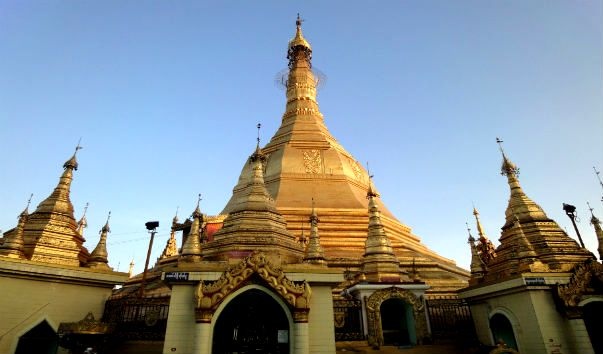The Sule Pagoda (Burmese, pronounced: [sʰúlè pʰəjáии]) is a Burmese stupa located in the heart of downtown Yangon, occupying the centre of the city and an important space in contemporary Burmese politics, ideology and geography. According to legend, it was built before the Shwedagon Pagoda during the time of the Buddha, making it more than 2,500 years old. Burmese legend states that the site for the Shwedagon Pagoda was asked to be revealed from an old nat who resided at the place where the Sule Pagoda now stands. The Sule Pagoda has been the focal point of both Yangon and Burmese politics. It has served as a rallying point in both the 1988 uprisings and 2007 Saffron Revolution
The Sule Pagoda incorporated the original Indian structure of the stupa, which initially was used to replicate the form and function of a relic mound. However, as Burmese culture became more independent of its South Indian influences, local architectural forms began to change the shape of the pagoda. It is believed to enshrine a strand of hair of the Buddha that the Buddha himself is said to have given to the two Burmese merchant brothers, Tapissa and Balika. The dome structure, topped with a golden spire, extends into the skyline, marking the cityscape.
An artistic rendition of Sularata, the nat of Sule Pagoda
According to Burmese legend the site where the Sule pagoda now stands was once the home of a powerful nat (spirit) named Sularata (the Sule Nat). The king of the Nats, Sakka, wished to help the legendary king Okkalap build a shrine for the Buddha's sacred hair-relic on the same site where three previous Buddhas had buried sacred relics in past ages. Unfortunately, these events had happened so long ago that not even Sakra knew exactly where the relics were buried. The Sule nat, however, who was so old that his eyelids had to be propped up with trees in order for him to stay awake, had witnessed the great event. The gods, Nats and humans of the court of Okkalapa therefore gathered around the Sule Ogre and asked him the location, which he eventually remembered.
The Sule Pagoda was made the center of Yangon by Lt. Alexander Fraser of the Bengal Engineers, who created the present street layout of Yangon soon after the British occupation in the middle of the 19th century. (Lt. Fraser also lent his name to Fraser Street, now Anawrattha Street and still one of the main thoroughfares of Yangon). It is a Mon-style chedi (pagoda), octagonal in shape, with each side 24 feet long; its height is 144 feet, 9 l/2 inches. Except for the chedi itself, enlarged to its present size by Queen Shin Sawbu (1453–1472), nothing at the pagoda is more than a little over a century old. Around the chedi are ten bronze bells of various sizes and ages with inscriptions recording their donors' names and the dates of their dedication. Various explanations have been put forward for the name, of varying degrees of trustworthiness: according to legend it was called su-way, meaning "gather around", when Okkapala and the divine beings inquired about the location of Singattura Hill, and the pagoda was then built to commemorate the event; another legend connects it su-le, meaning wild brambles, with which it was supposedly overgrown, and a non-legendary suggestion links it to the Pali words cula, meaning "small" and ceti, "pagoda











